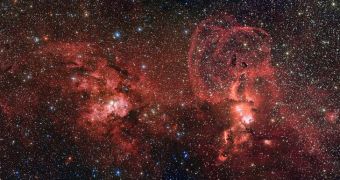Just a few days ago, the European Southern Observatory released this image showing two star formation regions located in the southern region of our home galaxy, the Milky Way.
Scientists explains that, of the two clusters featured in the image (be sure to click on it to get the full impact), the one on the left is known to the scientific community as NGC 3603. The one on the right is dubbed NGC 3576.
It is estimated that the first of these star forming regions sits at a distance of about 20,000 light years. The other one is located much closer. Specifically, one would only have to cover 9,000 light years to reach it.
Both these clusters sit in the Carina-Sagittarius spiral arm of the Milky Way galaxy, and they are now busy birthing new stars. Still, it looks like NGC 3603 is a tad more active than its companion, NGC 3576.
The clusters were discovered by astronomer John Herschel back in 1834, and have since been the subject of several studies and investigations, folks with the European Southern Observatory explain.
Thus, not too long ago, it was revealed that NGC 3603 has the highest concentration of massive stars that has until now been documented in our galaxy, and that NGC 3576 is home to two dust and gas formations that resemble ram horns.

 14 DAY TRIAL //
14 DAY TRIAL //